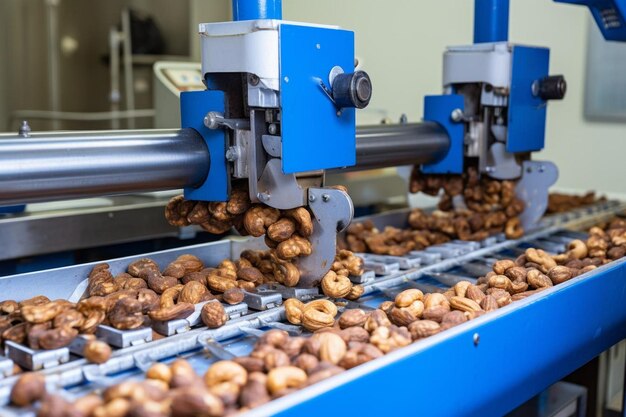In the world of agricultural processing, the quest for efficiency and precision often leads to groundbreaking innovations, such as the high-efficiency walnut cracking machine detailed in the latest research by Junhua Zhao, Li Li, Lingling Li, and Yunfeng Zhang. This novel device introduces a self-grading and multi-station extrusion mechanism that promises to revolutionize the walnut cracking process. Traditionally, walnut cracking has been a labor-intensive task with a high propensity for kernel damage, directly impacting the quality and economic value of the final product.
The team’s research focused on developing a machine that not only increases efficiency but also minimizes the damage to walnut kernels, a critical aspect for producers looking to maximize yield and profitability. Through rigorous theoretical investigation and empirical testing, a new approach was formulated. It involves a preliminary grading mechanism that categorizes walnuts by size and shape before they undergo the cracking process. This self-grading is achieved through a shaftless screw conveying mechanism alongside a grid-type trommel screen, ensuring that each nut is appropriately positioned for optimal cracking.
Furthermore, the extrusion mechanism of the cracking machine employs semi-arc plates, cleverly designed to apply alternating stress to the walnut shells, ensuring a higher cracking rate without compromising the integrity of the kernels. The research results showed impressive performance metrics: a grading rate of 87.3%, a shell-breaking rate of 91.50%, and a kernel-exposed rate of 84.72%. This high-efficiency walnut cracking machine not only streamlines operations but also enhances the overall quality and economic value of the walnuts processed, marking a significant advancement in the field of agricultural technology.
The innovative research into the high-efficiency walnut cracking machine by Junhua Zhao, Li Li, Lingling Li, and Yunfeng Zhang marks a pivotal shift in walnut processing technologies, a sector that has historically grappled with the trade-off between efficiency and product quality. Walnut processing, being crucial to agricultural economies especially in major producing countries like the United States, China, and Iran, has always necessitated improvements that could enhance throughput without sacrificing the integrity of the kernels. Indeed, the introduction of Zhao and team’s high-efficiency walnut cracking machine is a response to this exigent need within the industry.
Traditionally, the walnut cracking process involved mostly manual labor or rudimentary mechanical systems, which often resulted in inconsistent kernel quality due to unregulated force application. Moreover, small-scale operations frequently faced significant losses in both labor input and nut quality, which in turn affected profitability and market competitiveness. Addressing these challenges, researchers and engineers have been seeking to develop technologies that can reliably increase productivity and kernel retention rates.
Prior to this groundbreaking development, existing mechanical walnut crackers were typically generic in design, lacking specific adaptations for handling walnuts variably based on their size and shape. These machines often used a one-size-fits-all approach that led to high rates of kernel damage, reducing the quality and economic value of the output. The advent of the high-efficiency walnut cracking machine, with its precision in grading and cracking, heralds a new era in walnut processing technology.
Zhao and colleagues’ research was motivated by a holistic understanding of the issues plaguing the walnut industry. They saw the necessity for a system that could autonomously classify walnuts and adjust the cracking process accordingly, thus optimizing the handling of each individual nut. Their solution — using a shaftless screw conveyor aligned with a grid-type trommel screen for sorting followed by a multi-station extrusion mechanism — is particularly novel. This bespoke approach ensures that walnuts are not only sorted accurately but also handled gently, thereby maximizing the yield of whole kernels.
Furthermore, the research contextualizes itself within the broader movement towards automation and precision in agriculture. As food demand continues to grow globally, the agricultural sector is under increasing pressure to not only boost production rates but also enhance the quality and traceability of food products. The high-efficiency walnut cracking machine not only embodies this transition but also exemplifies how targeted engineering innovations can lead to significant improvements in food processing and agricultural outcome.
This breakthrough could set a precedent for future designs in agricultural machinery, fostering more research and development in nut processing technologies, and potentially spurring similar advancements for other types of agricultural produce. With such innovations, producers can look forward to higher efficiency, reduced waste, and improved economic returns, aligning with sustainable production goals that are increasingly vital in modern agricultural practices.
In the development of the high-efficiency walnut cracking machine, the research team employed a multi-faceted methodology that integrated both practical and theoretical approaches to address the challenges historically associated with walnut processing. The primary objective was to devise a machine that could maximize the cracking rate and minimize kernel damage, thereby increasing both efficiency and quality of output.
**Initial Theoretical Design and Simulation:** The first step involved theoretical design, wherein researchers utilized computer simulations to model the dynamics of walnut cracking. This stage was crucial for predicting how different designs would handle the stresses involved in cracking varied sizes and shapes of walnuts. The simulations helped in refining the design of the semi-arc plates used in the extrusion mechanism, ensuring that they provided optimal alternating stress without causing harm to the walnut kernels.
**Development of the Grading System:** A pivotal feature of the high-efficiency walnut cracking machine is its self-grading mechanism. This system was developed using a shaftless screw conveyor aligned with a grid-type trommel screen. The design was iteratively tested to ensure that it could efficiently categorize walnuts by size and shape, funneling them into appropriate tracks for cracking. This grading system was crucial in optimizing the cracking process tailored to the physical characteristics of each walnut, thereby reducing unnecessary damage.
**Prototyping and Empirical Testing:** Following the theoretical design and grading system development, the team constructed a prototype of the high-efficiency walnut cracking machine. Empirical testing was extensively conducted to test the prototype under controlled conditions. Walnuts of different varieties and sizes were processed through the machine to evaluate performance in real-world scenarios. During this phase, metrics such as the grading rate, shell-breaking rate, and kernel-exposed rate were meticulously measured. Adjustments were made to both the grading and extrusion mechanisms to enhance performance based on empirical results.
**Performance Evaluation and Optimization:** The final stage involved evaluating the machine’s performance over extended periods to ensure consistency and reliability. The collected data was analyzed to ascertain efficiency metrics and identify any potential areas for improvement. The design was fine-tuned to maximize the throughput and quality of the processed walnuts. Special attention was paid to ensuring that the machine could operate continuously at peak efficiency without the need for frequent maintenance.
**Collaborative Review and Iteration:** Throughout the process, the research team collaborated with industry experts and other researchers to refine the methodology. Feedback from these consultations was instrumental in enhancing the design and functionality of the high-efficiency walnut cracking machine.
This comprehensive methodology ensured that the high-efficiency walnut cracking machine was not only innovative in its approach to solving traditional problems but also robust in its application, setting a new standard in walnut processing technology.
The research on the high-efficiency walnut cracking machine led by Junhua Zhao et al. produced significant findings that mark a transformative advancement in the field of agricultural processing technologies. Through a meticulously structured experimental design and robust evaluation, this innovative machine demonstrated its efficacy in addressing the longstanding challenges associated with walnut cracking.
**Key Findings:**
1. **Efficiency in Grading and Sorting:**
The machine’s self-grading mechanism, which integrates a shaftless screw conveyor with a grid-type trommel screen, successfully classified walnuts by size and shape with a high grading rate of 87.3%. This innovative feature ensures that each walnut is allocated to the appropriate cracking station, thereby minimizing the handling errors and improving the overall efficiency of the process.
2. **Enhanced Shell-Breaking Rate:**
One of the standout achievements of the high-efficiency walnut cracking machine is its impressive shell-breaking rate of 91.50%. The introduction of semi-arc plates in the extrusion mechanism played a crucial role in this performance. These plates are designed to apply alternating stress on the walnut shells, effectively breaking them while preserving the integrity of the kernels.
3. **Kernel Integrity and Exposure:**
The preservation of kernel quality is paramount in walnut processing, as it directly influences market value. The high-efficiency walnut cracking machine achieved a kernel-exposed rate of 84.72%. This high rate of kernel exposure while maintaining kernel integrity is a testament to the precision engineered into the machine’s design, optimizing the balance between cracking efficiency and product quality.
4. **Reduction in Kernel Damage:**
Traditionally, kernel damage has been a pervasive issue in walnut cracking, primarily due to inappropriate force application and non-uniform nut sizes and shapes. The controlled and tailored cracking mechanism of this machine significantly minimizes kernel damage, which is crucial for maintaining the economic value of the final product.
**Results and Impact:**
The introduction of the high-efficiency walnut cracking machine brings forth multiple positive impacts on the walnut processing industry. It not only streamlines the cracking process but also enhances the overall quality and economic value of the walnuts. The ability of the machine to grade, sort, and effectively crack walnuts with minimal kernel damage paves the way for higher output quality, which is highly desired in the competitive nut market.
Moreover, the use of this machine could lead to substantial cost savings for producers by reducing labor costs associated with manual sorting and cracking, and decreasing losses due to damaged kernels. This machine epitomizes the integration of automation and precision in modern agricultural practices, aligning with sustainable production goals and helping producers achieve better market competitiveness.
Overall, these results not only signify a substantial leap forward in walnut processing technology but also open avenues for similar technological interventions across different sectors of agricultural processing. The high-efficiency walnut cracking machine could indeed serve as a model for future innovations in the agricultural industry, emphasizing the critical role of tailored machinery design in enhancing product quality and operational efficacy in food production.
Looking ahead, the successful development of the high-efficiency walnut cracking machine sets a promising trajectory for future advancements in nut processing and other agricultural machinery. This innovation not only transforms a traditionally cumbersome task but also serves as a blueprint that underscores the importance of tailored solutions in enhancing efficiency and quality in food production. The integration of advanced mechanical design with precise control systems in this machine could inspire a new generation of agricultural equipment optimized for various crops and conditions.
Presently, the adoption of the high-efficiency walnut cracking machine is poised to make significant impacts on the walnut industry. By addressing the critical pain points of kernel damage and inefficiency, this machine offers a solution that could reshape traditional practices, thereby propelling market competitiveness and sustainability in nut processing. The future direction could involve exploring the scalability of this technology, enhancing its adaptability to different walnut varieties and sizes, and even expanding its application to other types of nuts or agricultural products that require precise handling. The ability to customize the machinery to accommodate various agricultural demands represents a significant potential for growth and innovation in the sector.
Moreover, ongoing advancements in robotics and automation present opportunities for integrating more intelligent systems into the high-efficiency walnut cracking machine. Incorporating sensors and AI algorithms could further optimize the grading and cracking processes, potentially leading to even higher efficiency and lower rates of kernel damage. This could include real-time adjustments to cracking intensity based on walnut shell hardness detected by sensors, or machine learning models that predict optimal handling strategies based on accumulated processing data.
The environmental impact of agricultural practices continues to be a critical topic, and the development of machines like the high-efficiency walnut cracking machine contributes positively by reducing waste and improving the sustainability of food production. Future iterations of this technology could integrate greener technologies and energy-efficient designs that diminish the ecological footprint of nut processing.
Finally, the successful implementation and positive outcomes associated with the high-efficiency walnut cracking machine should encourage the industry and research communities to invest in similar technological innovations. This pursuit for improved agricultural tools aligns with global demands for food security and sustainable practices, ensuring that the sector can meet the challenges of a growing global population and environmental concerns.
In conclusion, the high-efficiency walnut cracking machine not only marks a significant milestone in agricultural processing technologies but also serves as a catalyst for further research and development in this vital field. As industries continue to seek solutions that combine efficiency with sustainability, technologies like this walnut cracking machine will play a pivotal role in defining the future of agriculture, making crucial contributions to global food supply chains and influencing policies on agricultural technology and food safety standards.
Related Articles:
– [Two-photon Clusteroluminescence Enabled by Through-Space Conjugation for In Vivo Bioimaging.](https://www.arkridgesciences.com/two-photon-clusteroluminescence-enabled-by-through-space-conjugation-for-in-vivo-bioimaging/)
– [[Ⅰ. Evaluation of Disease Burden of HPV-Related Head and Neck Cancer in Japan].](https://www.arkridgesciences.com/%e2%85%b0-evaluation-of-disease-burden-of-hpv-related-head-and-neck-cancer-in-japan/)
– [Moving Beyond the Temporal Bone Lab: Creating a Drilling Station in the Otolaryngology Clinic.](https://www.arkridgesciences.com/moving-beyond-the-temporal-bone-lab-creating-a-drilling-station-in-the-otolaryngology-clinic/)









